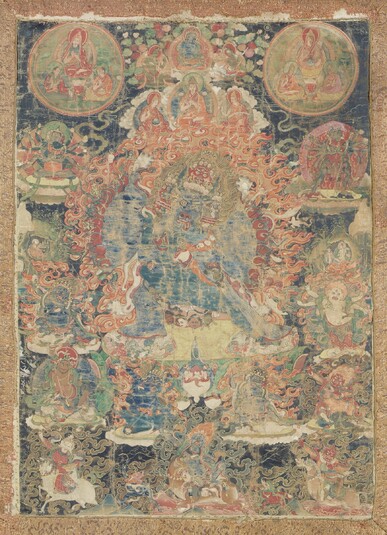
Item: Vajrabhairava (Buddhist Deity) - with consort
| Origin Location | Tibet |
|---|---|
| Date Range | 1800 - 1899 |
| Lineages | Gelug and Buddhist |
| Material | Ground Mineral Pigment on Cotton |
| Collection | Dr. David Nalin |
Classification: Deity
Appearance: Animal-Feature
Gender: Male
Vajrabhairava (Tibetan: dor je jig je. English: Vajra Terror) with the consort Vajra Vetali surrounded by the main protectors of the Gelugpa School. (For a similar composition see painting HAR #137).
Vajrabhairava, in the center, is terrifying and wrathful, dark blue in colour with nine faces, thirty-four hands and sixteen legs. The main face is that of a buffalo, with a red face above and the slightly angry yellow face of Manjushri placed on top. The three right faces are yellow, dark blue and red and the three left are black, white and smoky. Each face has three large round eyes, bared white fangs and frightful expressions; dark yellow hair flows upward; adorned with bone ornaments and a necklace of fifty heads. The first pair of hands hold a curved knife and skullcup embracing the consort. The remaining hands hold a variety of objects. Vajra Vetali has one face and two hands, blue in colour with orange hair pressed against the back; holding a skullcup in the left hand. The right legs of Bhairava are bent pressing down on various animals and gods. The left legs are extended straight and press upon various birds and gods; standing above an orange sun disc and multi-coloured lotus completely surrounded by the orange flames of pristine awareness.
At the top center is a Vajradhara, the primordial buddha, blue in colour, with one face and two hands holding a vajra and bell to the heart. On each side is a brown skinned Indian yogi with the appearance of a mahasiddha; possibly Saraha and Rahula, important early teachers in the teaching tradition. Below that is Tsongkapa with the two principal students Gyaltsab and Kedrub. All three wear yellow Tibetan pandita hats.
At the top left in a rainbow sphere is the Indian teacher Atisha with the student Dromton at the lower left. At the top right is a triad of three Tibetan lamas in a rainbow sphere.
Descending on the left is Akshobhyavajra Guhyasamaja, Shadbhuja Mahakala, Vaishravana Riding a Lion, and a Tibetan Mountain God, white and riding a white horse. Descending on the right is Chakrasamvara, Sita Shadbhuja Mahakala, Begtse Chen and Tsiu Marpo. Directly below the seat of Vajrabhairava, on the left, is Yama Dharmaraja with a buffalo face and riding a buffalo. On the right is Chaturmukha Mahakala with four faces and four hands. At the bottom center is Shri Devi Magzor Gyalmo with two attendant figures; water monster faced and lion faced.
As a principal meditational deity Vajrabhairava, sometimes referred to as Yamantaka, belongs to the Bhairava and Yamari class of tantras and specifically arises from the Vajrabhairava Root Tantra (Tib.: jig je tsa gyu). All of those belong to the method (father) classification of Anuttaryoga Tantra. The practice of Bhairava is common to the three Sarma Schools: Sakya, Kagyu and Gelug. Among the Sakya it is counted as one of the four main tantric deities along with Hevajra, Guhyasamaja and Chakrasamvara (Tib.: gyu de shi). Amongst the various Kagyu Schools the Drikungpa are strong upholders of the practice. There are numerous forms and styles of practice from the very complex with numerous deities to the very concise with a single Heruka form. From amongst the many lineages to enter Tibet the main ones were those of Rwa Lotsawa and Mal Lotsawa.
Jeff Watt 8-1998 [updated 6-2009]
Buddhist Deity: Vajrabhairava Main Page
Collection of Dr. David Nalin
Collection of Dr. David Nalin (Misc. Works)
Buddhist Deity: Vajrabhairava & Gelug Protectors Composition
